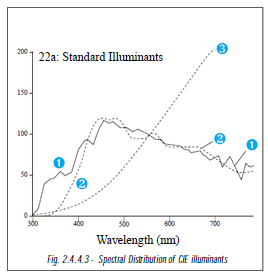Language of Light
2.Concepts
2.4 COLORIMETRY
2.4.4.3 SPECTRORADIOMETRY
Many different spectral power distribution curves can yield the same visual effect which we call colour. It means that the colour of a light source does not tell us the nature of its spectral power distribution. In other words, two different light sources which have the same colour in x,y or colour temperature might not exhibit the same spectral power distribution. The reverse, however, is true: knowledge of spectral power distribution of light will enable us to describe the colour (refer to Fig. 2.4.4.3 for the types of spectral power distribution curve of some common CIE illuminants).
Hence, the spectroradiometric method is the most accurate and complete method of specifying colour. The spectral data can be analysed visually and/or compared to data from another light source. However, the best use of spectral data is to calculate the CIE tristimulus values by mathematically integrating the data with the CIE colour-matching function. The tristimulus values are then used to compute CIE chromaticity coordinates and luminosity, which provide complete description of the colour.
![]() Standard Illuminant D65: Average daylight (including ultraviolet wavelength region) with a correlated colour temperature of 6504K.
Standard Illuminant D65: Average daylight (including ultraviolet wavelength region) with a correlated colour temperature of 6504K.![]() Standard Illuminant C: Average daylight (not including ultraviolet wavelength region) with a correlated colour temperature of 6774K.
Standard Illuminant C: Average daylight (not including ultraviolet wavelength region) with a correlated colour temperature of 6774K.![]() Standard Illuminant A: Incandescent light with a correlated colour temperature of 2856K.
Standard Illuminant A: Incandescent light with a correlated colour temperature of 2856K.


